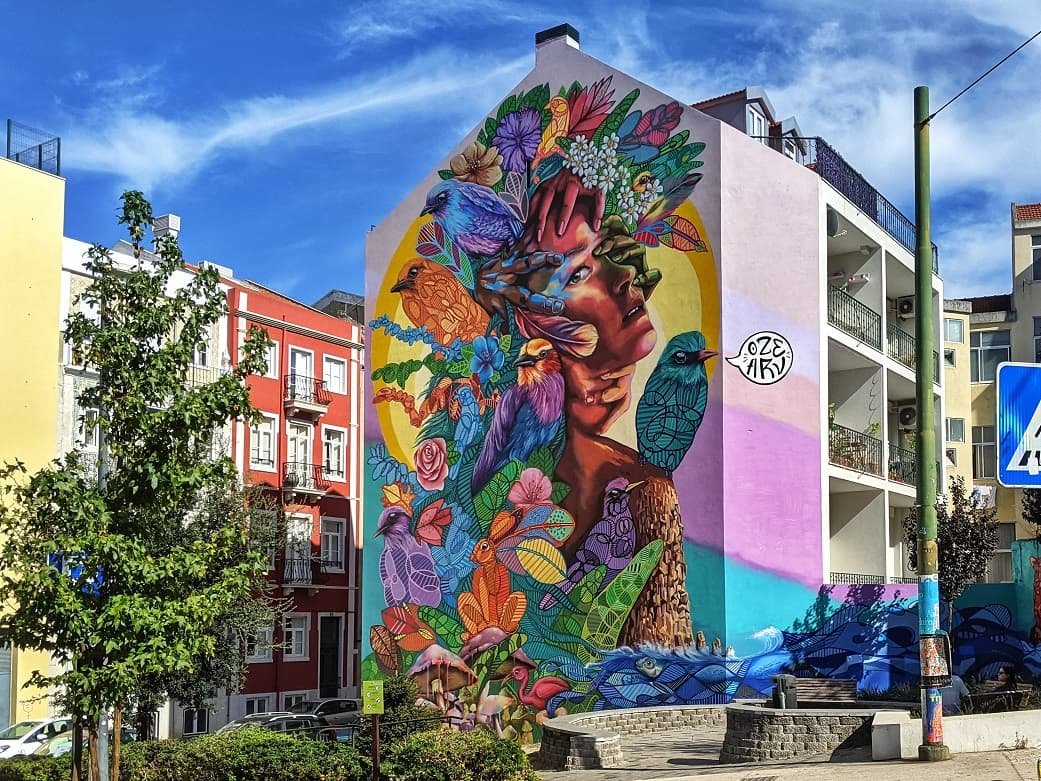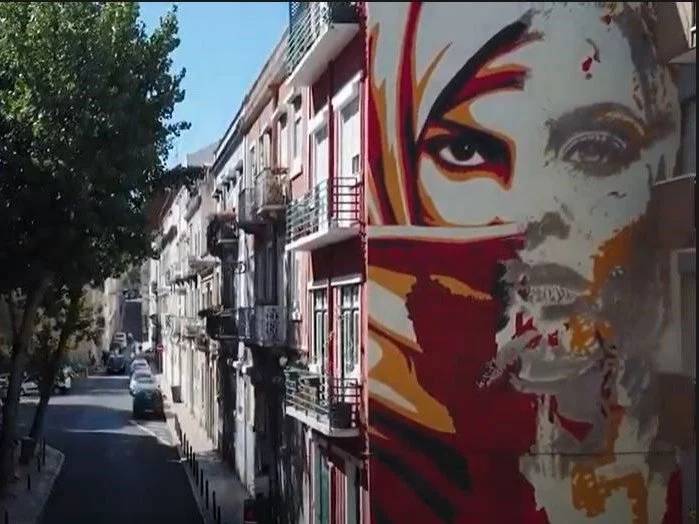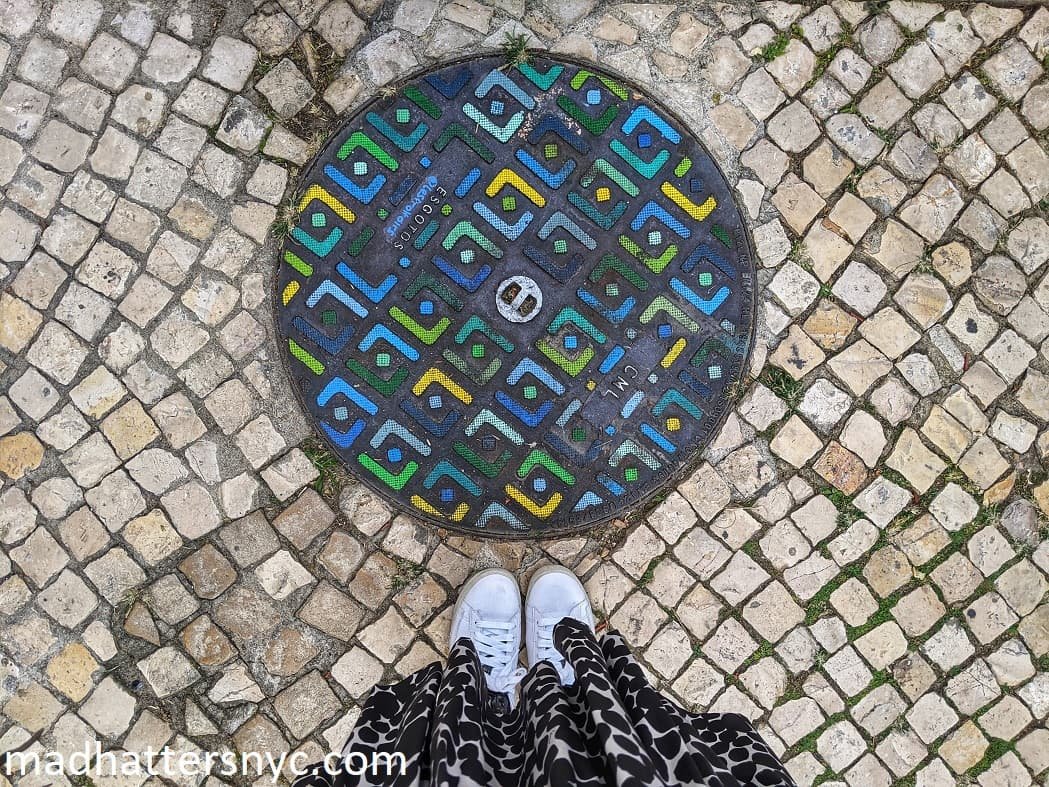A Graffiti Lover’s Guide to the Best Street Art and Murals in Lisbon
Lisbon is a city where street art seeps through every crack and oozes from every pore. It only takes a few hours in Portugal’s capital city to realize the murals aren’t casual doodles. The graffiti isn’t a series of careless scrawls. In this city where the old and the new harmoniously coexist, the diversity of street art styles perfectly complements the city’s varied architectural landscape. Though you can find it everywhere, these are the best areas to explore the city’s incredible street art scene.
Graça
Sophia de Mello Breyner by Daniel Eime
You can find Lisbon’s trendy Graça neighborhood within the larger Alfama district. Perched high on one of the city’s many hills, it offers sweeping views and is (thankfully!) easily accessible using the city’s famous Number 28 electric tram. Along Rua da Graça, OzeArv’s 2021 Tropical Fado in RGB Tones is an explosion of color, with a beguiling face gazing out through a halo of plants and animals expressed in the artist’s signature style. Daniel Eime’s stenciled portraits are known for their piercing gazes, and though this one only features half of poet Sophia de Mello Breyner’s face, it is just as disarming.
Peace Guard Lisbon by Shepard Fairey
American artist Shepard Fairey’s Peace Guard Lisbon mural is a faded, but still striking, piece. Fairey’s subject holds a gun with a flower in it, a symbolic reference to the Carnation Revolution in Portugal. Named for the demonstrators who placed carnations in the muzzles of guns and on the soldiers' uniforms, the 1974 military coup and civil resistance campaign transitioned the country from a dictatorship to a democracy. Fairey’s collaboration with internationally renowned Portuguese artist Vhils on Rua da Senhora da Glória is one of the most impressive street art pieces in the neighborhood.
In addition to the pieces along Rua da Graça, a winding staircase near Miradouro da Graça is also a treasure trove of graffiti and murals. The offerings are more raw, featuring a wide variety of artists and styles.
Miradouro de Santa Luzia
Also located in Alfama, Miradouro de Santa Luzia is one of Lisbon’s most beautiful outlooks. The panoramic views from the observation deck are complemented by the colorful trams passing by and the picturesque Praça Júlio de Castilho, with its azulejos and towering bougainvillea plants. But it’s also a necessary stop for street art enthusiasts.
Vandalized Historia de Lisboa mural
Panel depicting the departure of Vasco da Gama's fleet In search of the sea route to India
Its most famous artwork is Historia de Lisboa by local illustrator Nuno Saraiva. Originally painted in 2016, the mural depicts Lisbon’s history in comic book-style panels. Beginning with the city’s founding by Greek hero Ulysses while returning from the Trojan War, it continues through Lisbon's growth under the Islamic Caliphate, the construction of the Jeronimos Monastery at its zenith, the devastating 1755 Earthquake, and more. The famous piece was vandalized, so in 2021 students from the School of Art and Design in Caldas da Rainha endeavored to restore it and add new panels. Unfortunately, not long after the facelift, it was tagged over again.
Decorated sewer hole cover by Lestrottoirs
Lisa by Tami Hopf
If you continue down the staircase past this mural, you’ll find a variety of street art pieces around every corner. From modern azulejo street art to stickers, and wheat paste pieces to decorated sewer hole covers, there are pleasant discoveries all along the way. The captivating Lisa mural painted by illustrator and tattoo artist Tami Hopf is a perennial favorite. It has been shared thousands of times over social media since it was painted in 2016.
Parque das Nações
Iberian Lynx by Bordalo II
Parque das Nações was developed for the ambitious 1998 World Exposition, which celebrated the 500th anniversary of Portuguese explorer Vasco da Gama’s arrival in India. Expo '98 drew 11 million visitors to Lisbon. To support the expected influx of visitors, heavy investments in infrastructure included the Vasco da Gama Bridge, a new Lisbon Metro line, and the Oriente transportation hub. The modern commercial and residential district became a natural draw for artists. Bordalo II, who is known for creating street art animals out of repurposed materials, placed his gargantuan sculpture of an Iberian Lynx in the plaza to draw attention to the endangered species. We were introduced to Bordalo II on our first visit to Dublin, where we encountered his oversized Red Squirrel. The beloved Lisbon artist has recycled 62 tons of refuse through his art since 2012.
Unity by Pedro Podre and Perspective by Mabel Vicentef
The area is also a great place to find incredible street art thanks to the MURO Festival of Urban Art. With multiculturalism and sustainability as its major themes, the 4th iteration of the MURO Festival in 2021 added the work of 30 local and international street artists to the already rich graffiti landscape at Parque das Nações. Around the Casal dos Machados neighborhood, multi-level residences were transformed into colossal canvases. In his Unity mural, Porto artist Pedro Podre uses a network of intertwined hands to conjure an abstract “guardian” of the home. Meanwhile, Argentinian artist Mabel Vicentef employs expressive female faces to address crucial topics like women's rights, inequality and climate change. Her Perspective mural invites you to think about how someone else may influence, or even obstruct, your view.
Lisboa by Odeith and Shirt Mask by Metis
On one of Vasco da Gama Bridge’s pillars in Parque Tejo, Lisbon artist Odeith’s towering 3D lettering reflects his mastery of depth and dimension. On the opposing pillar, Nuno Viegas -- a talented Portuguese artist who goes by Metis -- paints a masked character hiding in plain sight.
Pro Tip: If you're planning on exploring Parque das Nações, take the opportunity to travel there by subway so you can explore the contemporary azulejo art featured in the Lisbon Metro stations. Once you arrive at Oriente, you'll also get to enjoy Santiago Calatrava's impressive architectural design.
Lx Factory
In a city as old as Lisbon, urban renewal is a natural part of its continued evolution. Lx Factory in Alcântara is one such shining success, breathing life into a defunct factory complex dating back to 1846. The mixed-use 6-acre complex is now a creative hub where co-working spaces, top-rated restaurants and interesting shops draw both locals and visitors alike. It’s no surprise that street art thrives here.
Darts & Hearts by Millo
The WOOL Urban Art Festival based in Covilhã has completed several “Wool on Tour” projects at Lx Factory, turning the industrial space into a large-scale street art gallery. With installations dating back to 2012, many prominent local and international talents are represented here. A 3D Bordalo II bee clings to the side of The Dorm, a modern take on hostel living, while Italian street artist Millo’s childlike giants watch over diners outside A Nata do Lx. Millo’s background in architectural studies is the foundation on which his signature cityscapes are built, but a sense of playfulness is always present in his work.
Timelessness by Jacqueline de Montaigne
Jacqueline de Montaigne, an Anglo-Portuguese artist based in Cascais, has several prominent works here, including Timelessness, her stunning David Bowie mural. Her signature swallows pop up when you least expect it, and always leave a lasting impression.
Pro Tip: While you’re visiting Lx Factory, be sure to pop in to Ler Devagar, a 20-year old bookstore that moved into the former home of Gráfica Miranda, a commercial printer. The giant printing presses, criss-crossing staircases and platforms, and suspended cutout sculptures make it one of the most stunning bookstores we’ve ever visited. It’s the perfect spot to grab a coffee and lose yourself in your favorite literary works.
Quinta do Cabrinha
Amália Rodrigues by Smile
While you’re in Alcântara, another worthwhile street art destination is the residential neighborhood of Quinta do Cabrinha. Thanks to a community revitalization project organized by street artist Ivo Santos, who also goes by the moniker Smile, the area is home to many impressive works of art.
Several murals adorning the interior courtyards pay tribute to Portuguese Fado music. Smile himself painted the portrait of Queen of Fado Amália Rodrigues, while graffiti artist Styler captured a portrait of her younger sister and equally well known fadista, Celeste Rodrigues. Lisbon visual artist 2CarryOn contributes to the Fado theme with a sky-high mural of a Portuguese guitar.
Mural by Jorge Charrua along Rua do Cabrinha
Although our Portuguese was barely passable, many residents were proud to talk about the murals and their depictions, and were also happy to point us in the direction of additional pieces. In and around the main residential complex, other artworks line the street, making a visit to this neighborhood a truly rewarding experience.
Ajuda
Interior of National Palace of Ajuda
Ajuda is a district located just northeast of Belém but many overlook it despite its proximity to the popular riverside destination. After the 1755 earthquake the Royal Family found refuge here, and its population quickly grew. There are still numerous reasons to visit, like the National Palace of Ajuda and the Ajuda Botanical Garden. In fact, one of our favorite Lisbon coffee shops is situated here. But for street art enthusiasts, the 2 de Maio neighborhood features some of the best murals the city has to offer.
Linen Ghost by Regg Salgado and Neighbors by Mariana Duarte Santos
It is rumored the residences in the neighborhood were originally constructed to accommodate members of the secret police. But when Portugal’s dictator was successfully overthrown in 1974, the housing project was abandoned. Many displaced locals who had been living in tents seized the opportunity and moved into the unfinished units and slowly turned them into livable spaces. In 2021, the Ajuda Parish Council worked with organizations like Museu de Lisboa and Galeria Arte Urbana on an ambitious urban art project for the community. Lisbon street artists Regg Salgado and Mariana Duarte Santos were asked to derive inspiration from paintings at Museu de Lisboa, but interpret them in the context of the neighborhood, its history and its residents.
An Opening in a Sea of Marble by Regg Salgado
In Memories of the Invasion, Santos depicts one of the neighborhood’s original inhabitants, along with original newspaper articles from the revolution and photos of loved ones strewn on the table. Regg Salgado’s An Opening in a Sea of Marble was inspired by his growing relationship with the residents. Salgado said, “Like onions, people have layers that protect them from the outside. Trust is something earned here.”
Avenida Infante Santo
When you approach the viaduct that connects Avenida Infante Santo and Avenida da Cintura do Porto de Lisboa, you’ll discover its walls are covered in an endless panel of rainbow-colored tiles. Completed by Portuguese artist Eduardo Nery in 2001, the cheerful installation is the beginning of a stretch affectionately called the Azulejo Route.
Azulejos are the ceramic tiles central to Portuguese culture. The National Museum of Azulejo is the perfect place to learn about the craft and its significance throughout history, but there’s nothing more exciting than seeing how it’s evolved into contemporary street art. If you continue north along Avenida Infante Santo, you’ll come across a stunning azulejo artwork titled Louvor da Vivacidade (Praise to a Living City) by Diogo Machado, also known as AddFuel. Completed in 2017, the installation is the newest addition to the route.
Further ahead, a textured piece by Eduardo Nery in shades of orange is another visual treat. Rolando Sá Nogueira’s azulejo mural depicts maritime scenes, while Carlos Botelho’s artwork features a candy-colored cityscape. The route offers a unique opportunity to experience works by other preeminent modern azulejo artists like Maria Keil and Júlio Pomar, whose creations also adorn the Lisbon Metro stations.
Conclusion
The prominence and ubiquity of street art in Lisbon is no accident. It’s a cosmopolitan city that exists as we know it today because of its strategic importance as a center for trade and commerce. Where you have trade, you have the mixing of cultures. Where you have the mixing of cultures, you have the evolution of ideas. So it should really come as no surprise that Lisbon embraced modern art forms, such as graffiti, instead of resisting them. Partnerships between municipalities and arts organizations have elevated the stature of street art in Lisbon and have led to its abundance. So as you wander around Lisbon, look up, look down and look around. We promise you won’t be disappointed.
Special thanks to zepasso.s and Street Art Chat, which are great Instagram accounts to follow for more street art inspiration.






















